Forests, Fields, and Pastures: Unequal Access to Brazil Nuts and Livelihood Strategies in an Extractive Reserve, Brazilian Amazon
Abstract
:1. Introduction
The Cazumbá–Iracema Extractive Reserve (CIER)—History, Governance Structure and Settlement Pattern
2. Materials and Methods
2.1. Study Site
2.2. Data Collection
2.3. Data Analysis
3. Results
3.1. Harvesting and Differential Access to Brazil Nuts
3.1.1. Direct (De Jure) Access
3.1.2. Indirect (De Facto) Access
3.1.3. Differences in Access between Communities
3.2. Comparison of Livelihood Profiles in the CIER
4. Discussion
“We don’t have Brazil nuts. And the money we make from Brazil nuts is little, tiny. And it’s only once a year. So, the problem with Brazil nuts is this: we don’t have Brazil nuts.”(Authorised user from community A)
“The Brazil nut is not everywhere. Here in this area, we have little, little. In some places there is none. Here on my land, there are only four Brazil nut trees. I use them only for my own consumption.”(Proprietor from community C)
“We can’t even clear an area. We can only clear a small area for a tiny field. For pasture, nobody can clear nor use fire. If we burn, we get a fine that we can’t even pay for.”
“After rubber and farinha came to nothing, we started to live off the income from cattle. So, the sustenance that we have today is from these cattle, and they want to take away our cattle.”
4.1. Understanding Unequal Access to Brazil Nuts in the CIER
4.2. Integrating Brazil Nut Access and Livelihood Strategies
4.3. Re-Assessing the Role of Cattle in the CIER and in Extractive Reserves
“For us to live from extractivism alone, it would be necessary for it to be valued. And it is not. If there is something to substitute cattle, we would abandon it at once. But if there isn’t, what can we do?”
5. Conclusions
Supplementary Materials
Author Contributions
Funding
Institutional Review Board Statement
Informed Consent Statement
Data Availability Statement
Acknowledgments
Conflicts of Interest
Appendix A. Brazil Nut Interview Question Guide
- Who owns the castanhal you harvest?
- How is harvest organized (in terms of division of labour and benefits)? Do women harvest?
- How do you transport the nuts?
- 4.
- How many castanhais/trees do you harvest?
- 5.
- Is there any variability in production (e.g., between trees or years)?
- 6.
- How much did you harvest this year (2015)? How much did you harvest last year (2014)?
- 7.
- Do you sell your Brazil nut production? If so, to whom?
- 8.
- For how much did you sell your production this year (2015)? For how much did you sell your production last year (2014)?
- 9.
- Do you sell your production individually or collectively?
- 10.
- Do you get any cash advances before harvest?
| 1 | Singular: colocação. |
| 2 | The most important state actor in the area is the Instituto Chico Mendes de Conservação da Biodiversidade (ICMBio)—Chico Mendes Institute for Biodiversity Conservation—a federal institution within the Ministry of the Environment. |
| 3 | The first author has since returned to the area for a total of four months. |
| 4 | The gender bias in our sample reflects the fact that men are generally regarded as heads of households but also that the gender of the first author made it harder to interview women, although women, usually the wife of the household head, were often present and intervened during interviews. Still, our study may have failed to capture important intra-household dynamics, including women’s access to resources, vast knowledge and use of plants, as well as income generating activities (e.g., [42]). We hope that further studies will be able to explicitly address women’s roles and accounts regarding the topics studied. |
| 5 | The range and median age (in years) of respondents in each of the three communities are: A (minimum = 20, maximum = 70, median = 40); B (minimum = 23, maximum = 75, median = 45); community C (minimum = 20, maximum = 57, median = 30). |
| 6 | The questions related to harvest figures, products’ prices, and activities’ economic importance refer to the years 2015 and 2014. Monetary values in Brazilian Reais (BRL) were converted to US Dollars (USD) using the rate of 23 May 2015: USD 1 = BRL 3.07. |
| 7 | By using such indicators as “presence in livelihood portfolio” and “primary source of income”, we sought to provide a basic description of livelihood portfolios in order to focus on the relationship between differential access to Brazil nuts and livelihood diversification. |
| 8 | The local terms are: dono de castanha (“Brazil nut owner”, that is, proprietor), pessoa que quebra castanha de meia (“person who harvests meia Brazil nuts”, that is, authorised user), and pessoa que não tem castanha (“person who has no Brazil nuts”, that is, no access). |
| 9 | Roads are inoperative during the inverno due to high rainfall. Conversely, high water levels in streams and rivers in the same period allow easy navigation. |
| 10 | Few households plant Brazil nuts because most think the trees take too long to produce. |
| 11 | There are also considerable productivity differences between trees and stands. |
| 12 | Community A in our sample is an exception to this general trend. For reasons that are elaborated in the discussion, productive areas of forest were parcelled out to extended families as part of an internally led land reform process in the 1990s. |
| 13 | Although rights to the land (colocações) and its resources are formally registered with the environmental body (ICMBio), arrangements about Brazil nut harvest are performed informally between households. |
| 14 | The scheme allows a group of 17 harvesters to participate and share in the harvest of Brazil nuts owned by three proprietors through the meia system. Requests for access to this specific scheme by households are discussed and decided by consensus in meetings between harvesters and an appointed coordinator. Proprietors or individuals with reliable income streams, such as teachers, are excluded from the scheme. |
| 15 | This does not mean that the smaller castanhais are “unimportant” or under-valued; precisely because they are not commercialised, they are important for local consumption, sharing and subsistence. |
| 16 | Bill Draft (Projeto de Lei) 313, 2020 (https://www.camara.leg.br/proposicoesWeb/fichadetramitacao?idProposicao=2237320, accessed on 20 June 2022), last updated on 18 August 2021. The bill draft must go through several levels of parliamentary analysis before it is submitted for approval by the president. |
References
- Brondizio, E. The Global Açaí: A Chronicle of Possibilities and Predicaments of an Amazonian Superfood. In Critical Approaches to Superfoods; McDonell, E., Wilk, R., Eds.; Bloomsbury Academic: London, UK; New York, NY, USA; Oxford, UK; New Delhi, India; Sydney, Australia, 2020. [Google Scholar]
- Guariguata, M.R.; Cronkleton, P.; Duchelle, A.E.; Zuidema, P.A. Revisiting the ‘cornerstone of Amazonian conservation’: A socioecological assessment of Brazil nut exploitation. Biodivers. Conserv. 2017, 26, 2007–2027. [Google Scholar] [CrossRef]
- Kainer, K.A.; Wadt, L.H.O.; Staudhammer, C.L. The evolving role of Bertholletia excelsa in Amazonia: Contributing to local livelihoods and forest conservation. Desenvolv. Meio Ambiente 2018, 48, 477–497. [Google Scholar] [CrossRef]
- Scoles, R.; Gribel, R. Human Influence on the Regeneration of the Brazil Nut Tree (Bertholletia excelsa Bonpl., Lecythidaceae) at Capanã Grande Lake, Manicoré, Amazonas, Brazil. Hum. Ecol. 2015, 43, 843–854. [Google Scholar] [CrossRef]
- Zeidemann, V.; Kainer, K.A.; Staudhammer, C.L. Heterogeneity in NTFP quality, access and management shape benefit distribution in an Amazonian extractive reserve. Environ. Conserv. 2013, 41, 242–252. [Google Scholar] [CrossRef]
- Myers, R.; Hansen, C.P. Revisiting A Theory of Access: A review. Soc. Nat. Resour. 2020, 33, 146–166. [Google Scholar] [CrossRef]
- Salisbury, D.S.; Schmink, M. Cows versus rubber: Changing livelihoods among Amazonian extractivists. Geoforum 2007, 38, 1233–1249. [Google Scholar] [CrossRef]
- Ribot, J.C.; Peluso, N.L. A Theory of Access. Rural. Sociol. 2003, 68, 29. [Google Scholar] [CrossRef]
- Peluso, N.L.; Ribot, J. Postscript: A Theory of Access RevisitEd. Soc. Nat. Resour. 2020, 33, 300–306. [Google Scholar] [CrossRef]
- Castro, F. Patterns of Resource Use by Caboclo Communities in the Middle-Lower Amazon. In Amazon Peasant Societies in a Changing Environment; Adams, C., Murrieta, R., Neves, W., Harris, M., Eds.; Springer: Dordrecht, The Netherlands, 2009; pp. 157–177. [Google Scholar] [CrossRef]
- Calderón-Contreras, R.; White, C.S. Access as the Means for Understanding Social-Ecological Resilience: Bridging Analytical Frameworks. Soc. Nat. Resour. 2019, 33, 205–223. [Google Scholar] [CrossRef]
- Allegretti, M.H. Extractive reserves: An alternative for reconciling development and environmental conservation in Amazonia. In Alternatives to Deforestation: Steps toward Sustainable Use of the Amazonia Rain Forest; Anderson, A.B., Ed.; Columbia University Press: New York, NY, USA, 1990; pp. 252–264. [Google Scholar]
- Schwartzman, S. Extractive Reserves: The Rubber Tappers’ Strategy for Sustainable Use of the Amazon Rain Forest. In Fragile Lands in Latin America: Strategies for Sustainable Development; Browder, J.O., Ed.; Westview Press: Boulder, CO, USA, 1989; pp. 150–165. [Google Scholar]
- Schmink, M.; Duchelle, A.; Hoelle, J.; Leite, F.; d’Oliveira, M.V.; Vadjunec, J.; Valentim, J.; Wallace, R. Forest Citizenship in Acre, Brazil. In Forests under Pressure—Local Responses to Global Issues; Katila, P., Galloway, G., Jong, W.D., Pacheco, P., Mery, G., Eds.; IUFRO: Vienna, Austria, 2014; Volume 32, p. 17. [Google Scholar]
- Cronkleton, P.; Taylor, P.L.; Barry, D.; Stone-Jovicich, S.; Schmink, M. Environmental Governance and the Emergence of Forest-Based Social Movements; CIFOR: Bogor, Indonesia, 2008; p. 44. [Google Scholar]
- Shepard, G.H.; Ramirez, H. “Made in Brazil”: Human Dispersal of the Brazil Nut (Bertholletia excelsa, Lecythidaceae) in Ancient Amazonia. Econ. Bot. 2011, 65, 44–65. [Google Scholar] [CrossRef]
- Duchelle, A.E.; Cronkleton, P.; Kainer, K.A.; Guanacoma, G.; Gezan, S. Resource Theft in Tropical Forest Communities: Implications for Non-timber Management, Livelihoods, and Conservation. Ecol. Soc. 2011, 16, 20. [Google Scholar] [CrossRef]
- Staudhammer, C.L.; Wadt, L.H.O.; Kainer, K.A.; da Cunha, T.A. Comparative models disentangle drivers of fruit production variability of an economically and ecologically important long-lived Amazonian tree. Sci. Rep. 2021, 11, 2563. [Google Scholar] [CrossRef] [PubMed]
- Ruiz-Pérez, M.; Almeida, M.; Dewi, S.; Costa, E.M.L.; Pantoja, M.C.; Puntodewo, A.; Postigo, A.d.A.; de Andrade, A.G. Conservation and Development in Amazonian Extractive Reserves: The Case of Alto Juruá. Ambio 2005, 34, 218–223. [Google Scholar] [CrossRef] [PubMed]
- Gomes, C.V.A.; Perz, S.G.; Vadjunec, J.M. Convergence and Contrasts in the Adoption of Cattle Ranching: Comparisons of Smallholder Agriculturalists and Forest Extractivists in the Amazon. J. Lat. Am. Geogr. 2012, 11, 99–120. [Google Scholar] [CrossRef]
- Schwartzman, S. Chico Mendes, the rubber tappers and the Indians: Reimagining conservation and development in the Amazon. Desenvolv. Meio Ambiente 2018, 48, 56–73. [Google Scholar] [CrossRef]
- Wallace, R.H.; Gomes, C.V.A.; Cooper, N.A. The Chico Mendes Extractive Reserve: Trajectories of agro-extractive development in Amazonia. Desenvolv. Meio Ambiente 2018, 48, 184–213. [Google Scholar] [CrossRef]
- Shepherd, G.; Warner, K.; Hogarth, N. Forests and poverty: How has our understanding of the relationship been changed by experience? Int. For. Rev. 2020, 22, 15. [Google Scholar] [CrossRef]
- Antunes, A.; Simmons, C.S.; Veiga, J.P. Non-Timber Forest Products and the Cosmetic Industry: An Econometric Assessment of Contributions to Income in the Brazilian Amazon. Land 2021, 10, 588. [Google Scholar] [CrossRef]
- Ostrom, E. Governing the Commons: The Evolution of Institutions for Collective Action; Cambridge University Press: Cambridge, UK, 1990. [Google Scholar]
- Schlager, E.; Ostrom, E. Property-Rights Regimes and Natural Resources: A Conceptual Analysis. Land Econ. 1992, 68, 249–262. [Google Scholar] [CrossRef] [Green Version]
- Alexiades, M.N.; Shanley, P. Forest Products, Livelihoods and Conservation: Case Studies of Non-Timber Forest Product Systems. In Forest Products, Livelihoods and Conservation: Case Studies of Non-timber Forest Product Systems; Alexiades, M.N., Shanley, P., Eds.; CIFOR: Bogor, Indonesia, 2005. [Google Scholar]
- Vogt, N.D.; Pinedo-Vasquez, M.; Brondízio, E.S.; Almeida, O.; Rivero, S. Forest Transitions in Mosaic Landscapes: Smallholder’s Flexibility in Land-Resource Use Decisions and Livelihood Strategies From World War II to the Present in the Amazon Estuary. Soc. Nat. Resour. 2015, 28, 1043–1058. [Google Scholar] [CrossRef]
- Allegretti, M. The social construction of public policies—Chico Mendes and the seringueiros movement. Desenvolv. Meio Ambiente 2008, 18, 39–59. [Google Scholar] [CrossRef] [Green Version]
- Fearnside, P.M. Extractive Reserves in Brazilian Amazonia. BioScience 1989, 39, 387–393. [Google Scholar] [CrossRef]
- Vadjunec, J.M.; Rocheleau, D. Beyond Forest Cover: Land Use and Biodiversity in Rubber Trail Forests of the Chico Mendes Extractive Reserve. Ecol. Soc. 2009, 14, 22. [Google Scholar] [CrossRef] [Green Version]
- Pantoja, M.C. ‘Vegetal Leather’: Latex (Hevea brasiliensis Müll. Arg.) in style. In Forest Products, Livelihoods and Conservation: Case Studies of Non-Timber Forest Product Systems; Alexiades, M., Shanley, P., Eds.; CIFOR: Bogor, Indonesia, 2004; Volume 3, p. 17. [Google Scholar]
- Almeida, M.W.B.d. Direitos à floresta e ambientalismo: Seringueiros e suas lutas. Rev. Bras. Ciências Sociais 2004, 19, 21. [Google Scholar] [CrossRef] [Green Version]
- Vadjunec, J.M.; Gomes, C.V.A.; Ludewigs, T. Land-use/land-cover change among rubber tappers in the Chico Mendes Extractive Reserve, Acre, Brazil. J. Land Use Sci. 2009, 4, 249–274. [Google Scholar] [CrossRef]
- Sills, E.; Saha, S. Subsidies for Rubber: Conserving Rainforests While Sustaining Livelihoods in the Amazon? J. Sustain. For. 2010, 29, 152–173. [Google Scholar] [CrossRef]
- Schmink, M. Forest citizens: Changing Life Conditions and Social Identities in the Land of the Rubber Tappers. Lat. Am. Res. Rev. 2011, 46, 18. [Google Scholar] [CrossRef]
- ICMBio. Plano de Manejo da Reserva Extrativista do Cazumbá-Iracema; MMA, Ed.; MMA: Sena Madureira, Brazil, 2007; p. 206.
- Pinedo-Vasquez, M.; Padoch, C. Urban, rural and in-between: Multi-sited households, mobility and resource management in the Amazon flood plain. In Mobility and Migration in Indigenous Amazonia: Contemporary Ethnoecological Perspectives; Alexiades, M.N., Ed.; Berghahn: Oxford, UK; New York, NY, USA, 2009; pp. 86–96. [Google Scholar]
- IBGE. Mapa Exploratório de Solos: Estado do Acre; IBGE: Brasília, Brazil, 2005.
- Bernard, H.R. Research Methods in Anthropology: Qualitative and Quantitative Approaches, 6th ed.; Rowman & Littlefield: Lanham, MD, USA, 2018. [Google Scholar]
- Weller, S.C.; Vickers, B.; Bernard, H.R.; Blackburn, A.M.; Borgatti, S.; Gravlee, C.C.; Johnson, J.C. Open-ended interview questions and saturation. PLoS ONE 2018, 13, e0198606. [Google Scholar] [CrossRef] [Green Version]
- Kainer, K.A.; Duryea, M.L. Tapping Women’s Knowledge: Plant Resource Use in Extractive Reserves, Acre, Brazil. Econ. Bot. 1992, 46, 18. [Google Scholar] [CrossRef]
- Ortiz, E.G. Brazil nut (Bertholletia excelsa). In Tapping the Green Market: Certification and Management of Non-Timber Forest Products; Shanley, P., Pierce, A.R., Laird, S.A., Guillen, A., Eds.; Earthscan: London, UK, 2002; pp. 61–74. [Google Scholar]
- Duchelle, A.E.; Almeyda Zambrano, A.M.; Wunder, S.; Börner, J.; Kainer, K.A. Smallholder Specialization Strategies along the Forest Transition Curve in Southwestern Amazonia. World Dev. 2014, 64, S149–S158. [Google Scholar] [CrossRef] [Green Version]
- Hecht, S.B. Factories, Forests, Fields and Family: Gender and Neoliberalism in Extractive Reserves. J. Agrar. Chang. 2007, 7, 316–347. [Google Scholar] [CrossRef]
- Belcher, B.; Schreckenberg, K. Commercialisation of Non-timber Forest Products: A Reality Check. Dev. Policy Rev. 2007, 25, 355–377. [Google Scholar] [CrossRef] [Green Version]
- Homma, A.K.O. Colhendo da Natureza: O Extrativismo Vegetal na Amazônia; Embrapa: Brasília, Brazil, 2018; p. 219. [Google Scholar]
- Virapongse, A. Social Mechanisms and Mobility: Buriti Palm (Mauritia flexuosa) Extractivism in Brazil. Hum. Ecol. 2017, 45, 119–129. [Google Scholar] [CrossRef]
- Castro, F.d. Local politics of floodplain tenure in the Amazon. Int. J. Commons 2016, 10, 1–20. [Google Scholar] [CrossRef] [Green Version]
- Kainer, K.; Cymerys, M.; Wadt, L.; Argolo, V. Brazil nut. In Fruit Trees and Useful Plants in Amazonian Life; Shanley, P., Cymerys, M., Serra, M., Medina, G., Eds.; FAO, CIFOR and People and Plants International: Rome, Italy, 2011; p. 380. [Google Scholar]
- Zenteno, M.; Zuidema, P.A.; de Jong, W.; Boot, R.G.A. Livelihood strategies and forest dependence: New insights from Bolivian forest communities. For. Policy Econ. 2013, 26, 12–21. [Google Scholar] [CrossRef]
- Stoian, D. Harvesting windfalls: The Brazil nut (Bertholletia excelsa) economy in the Bolivian Amazon. In Forest Products, livelihoods and Conservation. Case Studies of Non-Timber Forest Product Systems; Alexiades, M.N., Shanley, P., Eds.; CIFOR: Bogor, Indonesia, 2005; Volume 3, pp. 83–110. [Google Scholar]
- Ribot, J.C. Theorizing Access: Forest Profits along Senegal’s Charcoal Commodity Chain. Dev. Chang. 1998, 29, 307–341. [Google Scholar] [CrossRef]
- Morin, E. Introduction à la Pensée Complexe; Editions Du Seuil: Paris, France, 2014; p. 160. [Google Scholar]
- Overing, J.; Passes, A. The Anthropology of Love and Anger: The Aesthetics of Conviviality in Native Amazonia; Routledge: New York, NY, USA, 2000. [Google Scholar]
- Harris, M. The Rhythm of Life on the Amazon Floodplain: Seasonality and Sociality in a Riverine Village. J. R. Anthropol. Inst. 1998, 4, 65–82. [Google Scholar] [CrossRef]
- Barber, C.P.; Cochrane, M.A.; Souza, C.M.; Laurance, W.F. Roads, deforestation, and the mitigating effect of protected areas in the Amazon. Biol. Conserv. 2014, 177, 203–209. [Google Scholar] [CrossRef]
- Schielein, J.; Ponzoni Frey, G.; Miranda, J.; de Souza, R.A.; Boerner, J.; Henderson, J. The role of accessibility for land use and land cover change in the Brazilian Amazon. Appl. Geogr. 2021, 132, 1–11. [Google Scholar] [CrossRef]
- Pérez, D.; Mora, R.; López Carrascal, C. Conservación de la diversidad de yuca en los sistemas tradicionales de cultivo de la Amazonía. Acta Biológica Colomb. 2019, 24, 202–212. [Google Scholar] [CrossRef]
- Walker, R.; Moran, E.; Anselin, L. Deforestation and Cattle Ranching in the Brazilian Amazon: External Capital and Household Processes. World Dev. 2000, 28, 683–699. [Google Scholar] [CrossRef]
- Escobal, J.; Aldana, U. Are Nontimber Forest Products the Antidote to Rainforest Degradation? Brazil Nut Extraction in Madre De Dios, Peru. World Dev. 2003, 31, 1873–1887. [Google Scholar] [CrossRef]
- Soriano, M.; Mohren, F.; Ascarrunz, N.; Dressler, W.; Pena-Claros, M. Socio-ecological costs of Amazon nut and timber production at community household forests in the Bolivian Amazon. PLoS ONE 2017, 12, e0170594. [Google Scholar] [CrossRef] [PubMed]
- Brondizio, E.; Safar, C.; Siqueira, A. The urban market of Acai fruit (Euterpe oleracea Mart.) and rural land use change: Ethnographic insights into the role of price and land tenure constraining agricultural choices in the Amazon estuary. Urban Ecosyst. 2002, 6, 67–97. [Google Scholar] [CrossRef]
- Hoelle, J. Convergence on Cattle: Political Ecology, Social Group Perceptions, and Socioeconomic Relationships in Acre, Brazil. Cult. Agric. Food Environ. 2011, 33, 95–106. [Google Scholar] [CrossRef]
- Hoelle, J. A chegada da Cultura Caubói no Acre, Brasil. Cad. De Geogr. 2020, 30, 461–483. [Google Scholar] [CrossRef]
- Kröger, M. Deforestation, cattle capitalism and neodevelopmentalism in the Chico Mendes Extractive Reserve, Brazil. J. Peasant. Stud. 2019, 47, 464–482. [Google Scholar] [CrossRef]
- Hecht, S.B.; Cockburn, A. The Fate of the Forest: Developers, Destroyers, and Defenders of the Amazon; Updated Edition; University of Chicago Press: Chicago, IL, USA, 2011. [Google Scholar]
- Santos, A.M.D.; Silva, C.; Almeida Junior, P.M.; Rudke, A.P.; Melo, S.N. Deforestation drivers in the Brazilian Amazon: Assessing new spatial predictors. J. Env. Manag. 2021, 294, 113020. [Google Scholar] [CrossRef]
- Ferrante, L.; Fearnside, P.M. Brazil’s new president and ‘ruralists’ threaten Amazonia’s environment, traditional peoples and the global climate. Environ. Conserv. 2019, 46, 261–263. [Google Scholar] [CrossRef]
- Tourneau, F.-M.L. O governo Bolsonaro contra os Povos Indígenas: As garantias constitucionais postas à prova. Confins 2019, 501, 1–17. [Google Scholar] [CrossRef] [Green Version]
- Pereira, R.; Rausch, L.L.; Carrara, A.; Gibbs, H.K. Extensive Production Practices and Incomplete Implementation Hinder Brazil’s Zero-Deforestation Cattle Agreements in Pará. Trop. Conserv. Sci. 2020, 13, 1–13. [Google Scholar] [CrossRef]
- ISA. Unidades de Conservação no Brasil. Available online: https://uc.socioambiental.org/ (accessed on 4 September 2021).
- Sessin-Dilascio, K.; Souza, T.S.; Rossi, C.B.; Sinisgalli, P.A.D.A. As Fronteiras entre Homem-Gado-Floresta. In Proceedings of the X Encontro Nacional da Anppas, Campinas, Brazil, 5 October 2021. [Google Scholar]
- Mascarenhas, F.D.S.; Brown, I.F.; Silva, S.S.d. Desmatamento e incêndios florestais transformando a realidade da Reserva Extrativista Chico Mendes. Desenvolv. Meio Ambiente 2018, 48, 236–262. [Google Scholar] [CrossRef]
- Futemma, C. The Use of and Access to Forest Resources: The Caboclos of the Lower Amazon and Their Socio-Cultural Attributes. In Amazon Peasant Societies in a Changing Environment; Springer: Dordrecht, The Netherlands, 2009; pp. 215–237. [Google Scholar] [CrossRef]
- Ostrom, E. Polycentric systems for coping with collective action and global environmental change. Glob. Environ. Chang. 2010, 20, 550–557. [Google Scholar] [CrossRef]
- Laird, S.A.; McLain, R.J.; Wynberg, R.P. Wild Product Governance: Finding Policies that Work for Non-Timber Forest Products; Earthscan: London, UK; Washington, DC, USA, 2010; p. 393. [Google Scholar]
- Brondizio, E.S.; Ostrom, E.; Young, O.R. Connectivity and the Governance of Multilevel Social-Ecological Systems: The Role of Social Capital. Annu. Rev. Environ. Resour. 2009, 34, 253–278. [Google Scholar] [CrossRef]
- Nagendra, H.; Ostrom, E. Polycentric governance of multifunctional forested landscapes. Int. J. Commons 2012, 6, 104–133. [Google Scholar] [CrossRef]
- Boulton, C.A.; Lenton, T.M.; Boers, N. Pronounced loss of Amazon rainforest resilience since the early 2000s. Nat. Clim. Chang. 2022, 12, 271–278. [Google Scholar] [CrossRef]
- Sales, L.P.; Rodrigues, L.; Masiero, R.; Hampe, A. Climate change drives spatial mismatch and threatens the biotic interactions of the Brazil nut. Glob. Ecol. Biogeogr. 2020, 30, 117–127. [Google Scholar] [CrossRef]
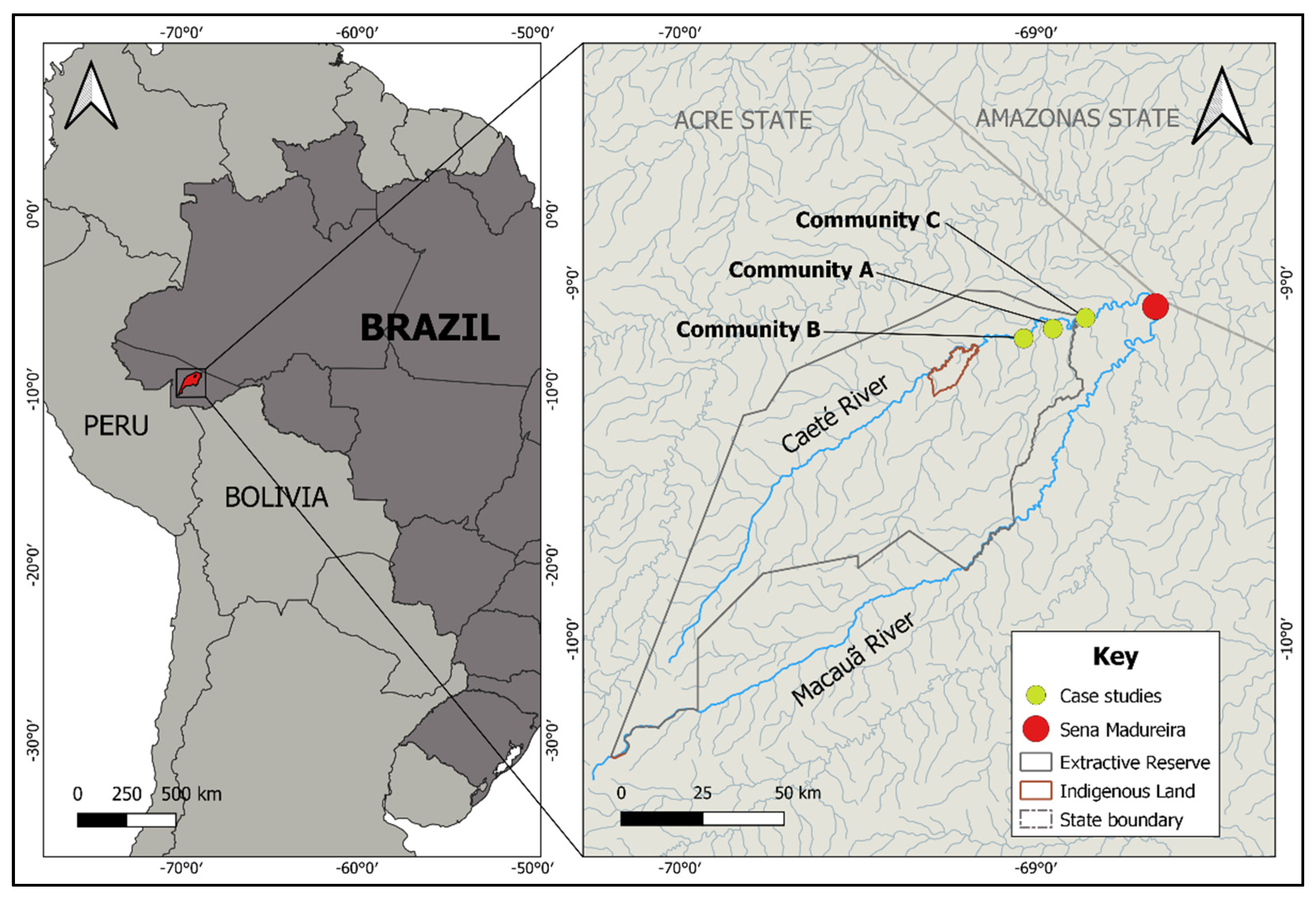
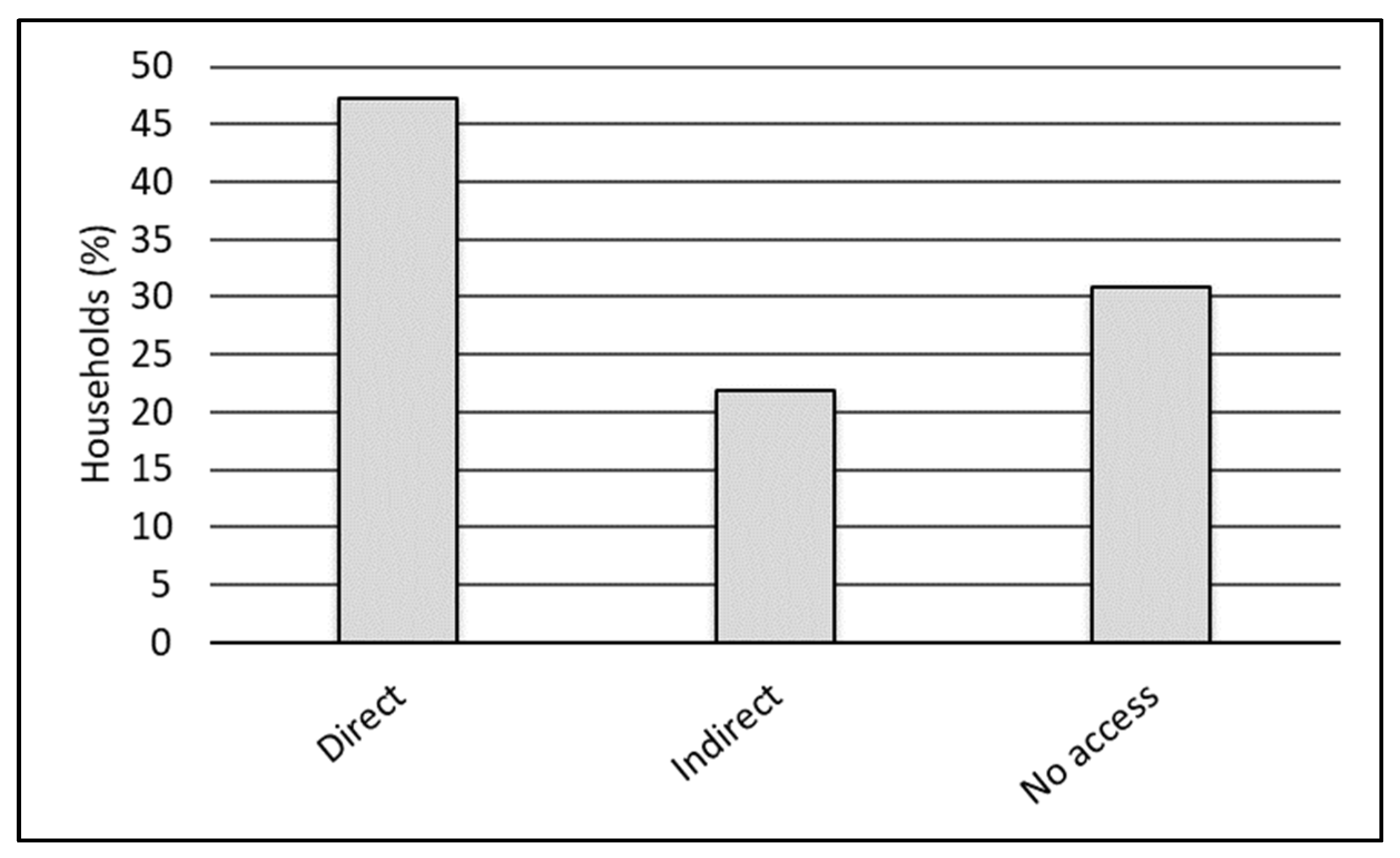
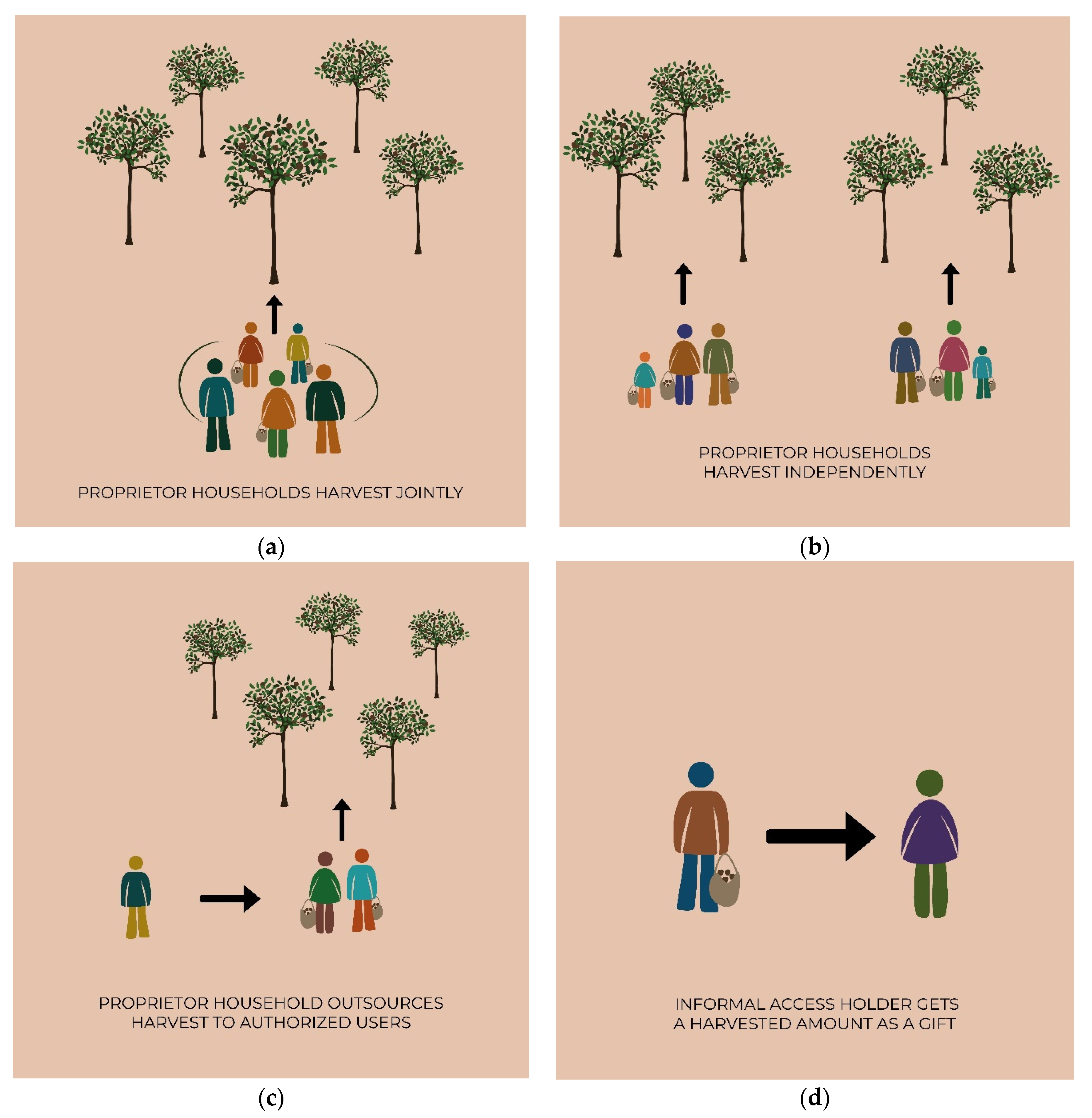
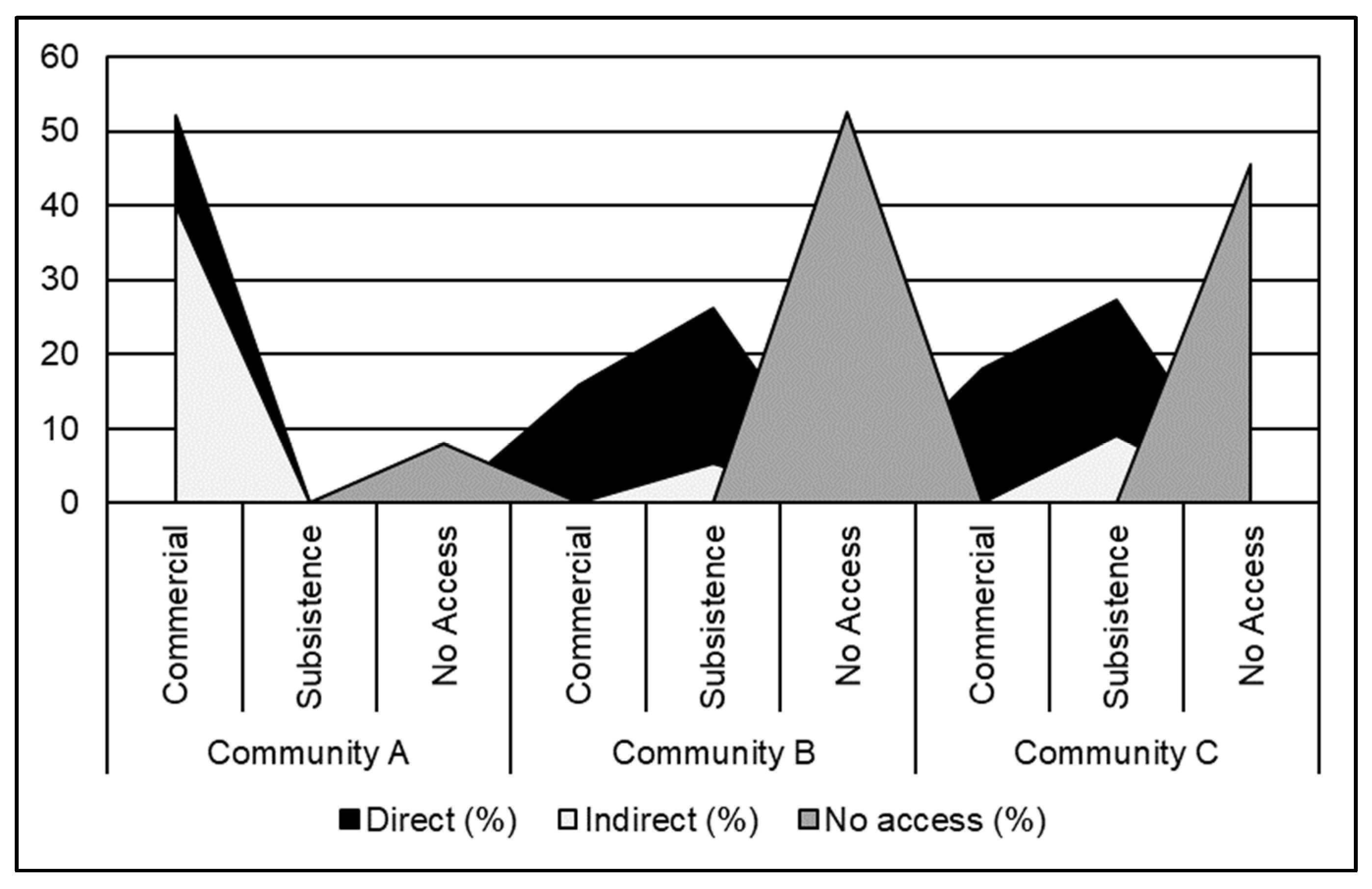
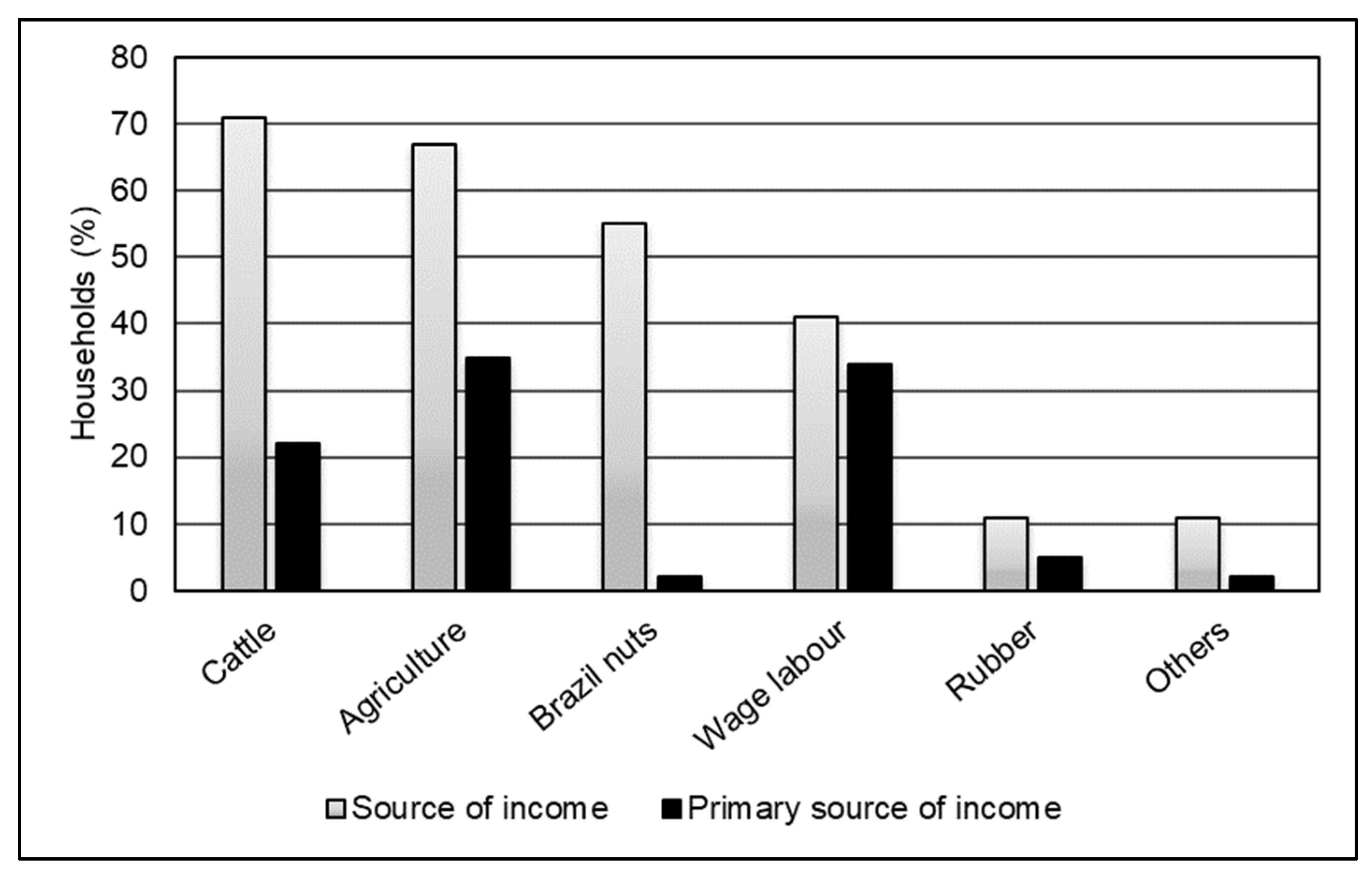
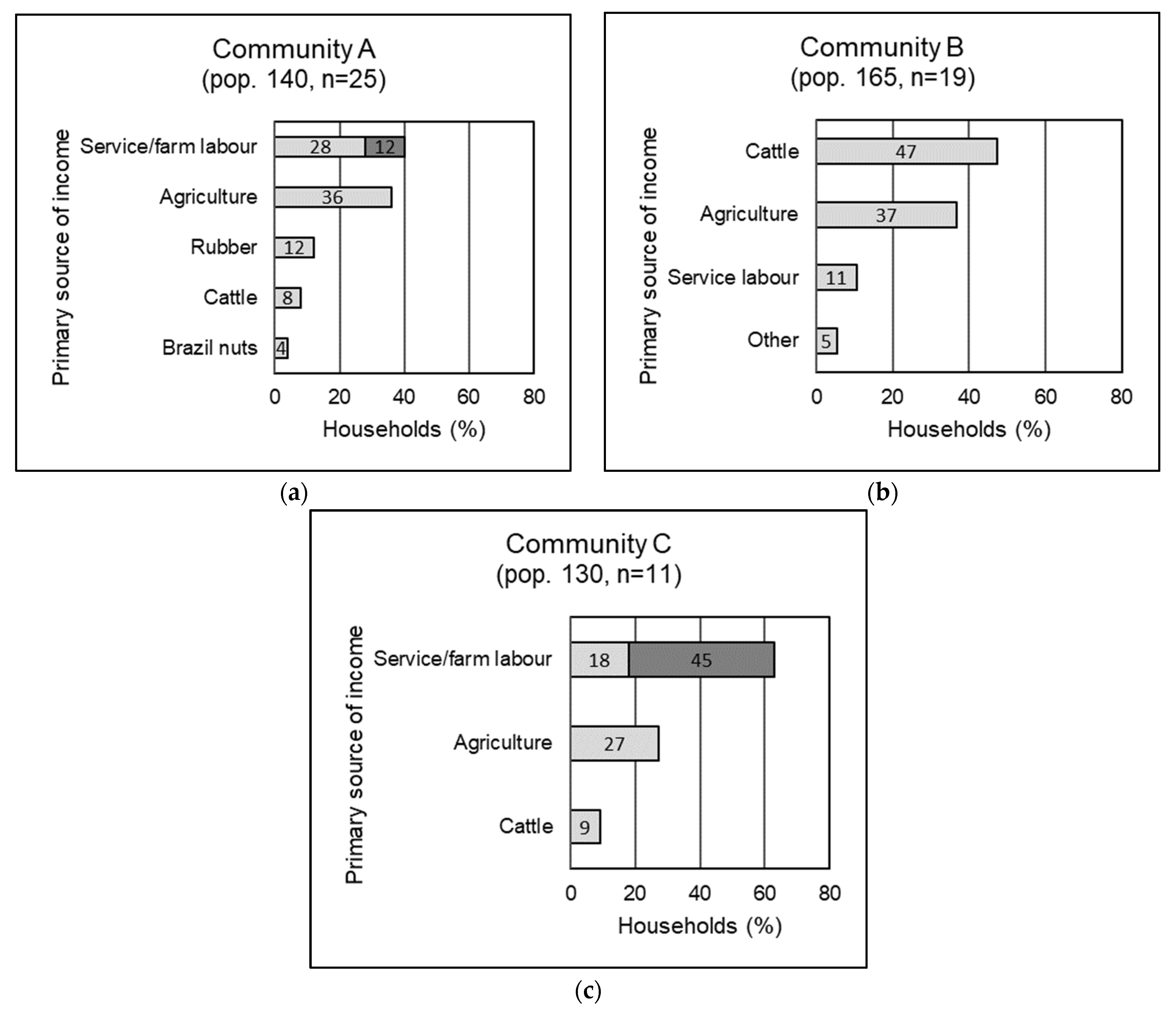
| Characteristic | Community A | Community B | Community C |
|---|---|---|---|
| Population (n) | 140 | 165 | 130 |
| Origin | Seringueiro families | Seringueiro families | Mixed seringueiro and migrant families |
| Settlement pattern | Nucleated | Traditional units (300–500 ha) | Small units (20–100 ha) |
| Occupation history | 30 years | ~95 years | ~15 years |
| Brazil nuts | Abundant | Moderate | Scarce |
| Access to town | By river (~4 h) with seasonal road access | By river (~6 h) with seasonal road access | By river (~2 h) with seasonal road access |
| Households | Community A | Community B | Community C | Total |
|---|---|---|---|---|
| Total | 35 | 41 | 32 | 108 |
| Interviewed | 25 | 19 | 11 | 55 |
| Percentage | 71 | 46 | 34 | 51 |
| Community/Castanhal | Trees (n) | Production (t) | Gross Revenue (k USD) | ||
|---|---|---|---|---|---|
| Community A * | 2014 | 2015 | 2014 | 2015 | |
| Castanhal 1—“Reserve”(C-gr) | 300 | 4.5 | 6.7 | 3.1 | 6.6 |
| Castanhal 2 (C-gr) | 180 | 5 | 10 | 3.4 | 9.8 |
| Castanhal 3 (C-gr) | 150 | 0.9 | 1.5 | 0.5 | 1.5 |
| Castanhal 4 (C-gr) | 120 | 0.8 | 1 | 0.6 | 1 |
| Castanhal 5 (C-ind) | 90 | 2.8 | 2.6 | 2.4 | 2.5 |
| Castanhal 6 (C-ind) | 55 | 0.7 | 1.1 | 0.5 | 1 |
| Castanhal 7 (C-ind) | 36 | 0 | 0.6 | 0 | 0.6 |
| Castanhal 8 (C-gr) | 25 | 0.2 | 0.7 | 0.2 | 0.7 |
| Subtotal | 956 | 14.9 | 24.2 | 10.7 | 23.7 |
| Community B * | |||||
| Castanhal 1 (C-gr) | 120 | 6.8 | 7 | 4.4 | 6.9 |
| Castanhal 2 (C-ind) | 80 | 0.7 | 2 | 0.5 | 2 |
| Castanhal 3 (C-ind) | 32 | 0.1 | 0.2 | 0.1 | 0.2 |
| Castanhal 4 (C-ind) | 20 | 0.4 | 0.5 | 0.3 | 0.5 |
| Castanhal 5 (S) | 10 | - | - | - | - |
| Castanhal 6 (S) | 10 | - | - | - | - |
| Castanhal 7 (S) | 6 | - | - | - | - |
| Castanhal 8 (S) | 2 | - | - | - | - |
| Castanhal 9 (S) | 1 | - | - | - | - |
| Subtotal | 281 | 8 | 9.7 | 5.3 | 9.6 |
| Community C * | |||||
| Castanhal 1 (C-gr) | 18 | 0.3 | 0.4 | 0.2 | 0.3 |
| Castanhal 2 (S) | 5 | - | 0.1 | - | 0.1 |
| Castanhal 3 (S) | 8 | - | - | - | - |
| Castanhal 4 (S) | 4 | - | - | - | - |
| Subtotal | 35 | 0.3 | 0.5 | 0.2 | 0.4 |
| Total | 1272 | 23.2 | 34.4 | 16.2 | 33.7 |
| Access Type | Term | Harvest Scheme | Social Relationship | |
|---|---|---|---|---|
| Direct | Proprietor | Division of labour | Division of trees | Kin |
| Indirect | Authorised user | Meia contract | Subsistence | Kin or friends |
Publisher’s Note: MDPI stays neutral with regard to jurisdictional claims in published maps and institutional affiliations. |
© 2022 by the authors. Licensee MDPI, Basel, Switzerland. This article is an open access article distributed under the terms and conditions of the Creative Commons Attribution (CC BY) license (https://creativecommons.org/licenses/by/4.0/).
Share and Cite
Ubiali, B.; Alexiades, M. Forests, Fields, and Pastures: Unequal Access to Brazil Nuts and Livelihood Strategies in an Extractive Reserve, Brazilian Amazon. Land 2022, 11, 967. https://doi.org/10.3390/land11070967
Ubiali B, Alexiades M. Forests, Fields, and Pastures: Unequal Access to Brazil Nuts and Livelihood Strategies in an Extractive Reserve, Brazilian Amazon. Land. 2022; 11(7):967. https://doi.org/10.3390/land11070967
Chicago/Turabian StyleUbiali, Bruno, and Miguel Alexiades. 2022. "Forests, Fields, and Pastures: Unequal Access to Brazil Nuts and Livelihood Strategies in an Extractive Reserve, Brazilian Amazon" Land 11, no. 7: 967. https://doi.org/10.3390/land11070967
APA StyleUbiali, B., & Alexiades, M. (2022). Forests, Fields, and Pastures: Unequal Access to Brazil Nuts and Livelihood Strategies in an Extractive Reserve, Brazilian Amazon. Land, 11(7), 967. https://doi.org/10.3390/land11070967






